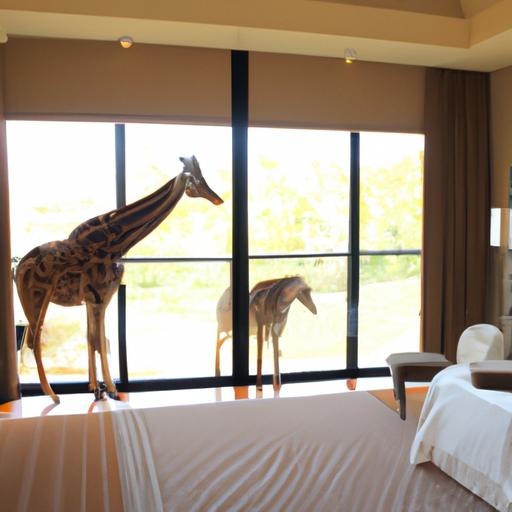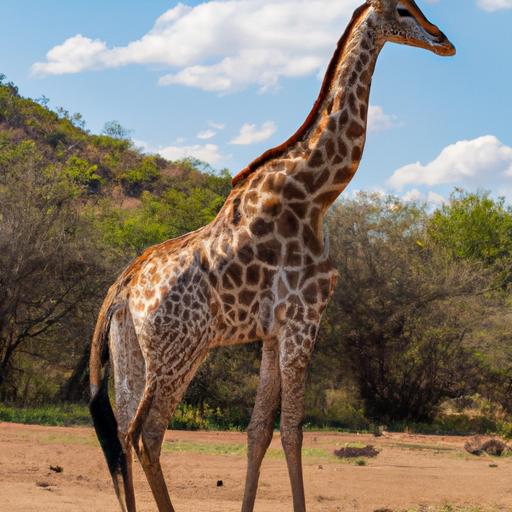Giraffes, the majestic creatures of the African savannah, have long captivated our imagination with their towering height and graceful demeanor. But have you ever wondered how these gentle giants go about the business of procreation? In this article, we delve into the fascinating realm of giraffe mating, shedding light on their intriguing reproductive behavior. By understanding how giraffes mate, we can gain valuable insights into their conservation and ensure the survival of these magnificent animals.
Introduction
As we embark on this journey into the mysterious world of giraffe mating, let’s start with an overview of their unique behavior. Giraffes, known for their polygamous nature, engage in a complex mating ritual that involves both males and females. The process is not only a means of propagating their species but also plays a crucial role in maintaining social harmony within giraffe herds.
Understanding how giraffes mate holds significant importance for researchers, conservationists, and wildlife enthusiasts alike. By unraveling the secrets of giraffe mating, we can contribute to their preservation and protect these gentle giants from the threats they face in the wild. Moreover, comprehending the intricacies of their reproductive behavior allows us to appreciate the beauty and complexity of nature’s design.
So, join me as we embark on this captivating exploration into the world of giraffe mating. Let’s uncover the rituals, challenges, and adaptations that make their reproductive process truly extraordinary.
Stay tuned for Section 2, where we delve into the fascinating reproductive behavior of giraffes during their mating season.
Reproductive Behavior of Giraffes
A. Mating Season and Timing
Giraffes, like many other animals, have a specific mating season. This period varies across different regions, but it often aligns with the rainy season when food is abundant. During this time, male giraffes become more active in their pursuit of potential mates, while females become more receptive to advances.
B. Male Giraffe’s Courtship Behavior
To woo a female, male giraffes engage in a fascinating display of courtship behavior. This typically involves necking, a behavior where two males engage in combat by swinging their necks and heads at each other. This ritual is not only a competition for dominance but also serves as a way for males to impress females with their strength and agility.
C. Female Giraffe’s Role in the Mating Process
While males may initiate courtship, female giraffes play an active role in the mating process. Once a male has successfully courted a female, she will assess his fitness and readiness to mate. If satisfied, she will position herself in a specific stance, known as lordosis, which signals her readiness for copulation. This allows the male to mount her from behind and proceed with mating.
In the next section, we will uncover the mesmerizing rituals that giraffes engage in during their mating process. Get ready to be amazed by their unique behaviors and vocalizations.
Giraffe Mating Rituals
Giraffe mating rituals are a spectacle to behold, showcasing unique behaviors that are both intriguing and essential for successful reproduction. Let’s dive into the fascinating world of giraffe courtship and explore the rituals that contribute to the continuation of their species.
A. Necking Behavior and its Significance
One of the most captivating aspects of giraffe mating is the behavior known as “necking.” This ritual involves male giraffes engaging in a fierce yet graceful battle, where they use their long necks as weapons to establish dominance and win the attention of females. Necking serves multiple purposes, including determining the strongest male and ensuring the survival of their genetic lineage.
During necking, male giraffes swing their necks forcefully at each other, aiming to strike their opponent’s body or neck. The sound of their necks colliding echoes through the savannah, creating a breathtaking display of strength and agility. This ritual not only establishes dominance but also showcases the physical fitness and genetic superiority of the males.
B. Stance and Positioning During Mating
Once a male giraffe has successfully established dominance through necking, the mating process begins. Giraffes adopt a unique stance during copulation, known as the “front-end mount.” In this position, the male stands behind the female, placing his front legs on either side of her hindquarters. This allows for better balance and stability during the mating process.
The positioning during giraffe mating is crucial for successful copulation. Due to the significant height difference between male and female giraffes, proper alignment is necessary to ensure effective penetration. This intricate dance between the two individuals highlights the adaptability and coordination required for giraffes to reproduce successfully.
C. The Role of Vocalizations in Giraffe Mating
Giraffes are not only known for their impressive stature but also for their unique vocalizations, which play an important role in the mating process. Male giraffes emit low-frequency vocalizations, referred to as “infrasounds,” during courtship. These deep, rumbling calls can travel long distances, allowing males to communicate their presence and attract potential mates.
The vocalizations of male giraffes serve as a form of advertisement, signaling their availability and dominance to females in the vicinity. Additionally, these infrasounds may help in synchronizing mating behavior within a herd. By understanding and decoding these vocalizations, researchers can gain insights into the communication strategies and social dynamics of giraffes during the mating season.
Continue reading in Section 4, where we explore the copulation process of giraffes and uncover the duration and frequency of their mating encounters.
Copulation Process of Giraffes
Among the many fascinating aspects of giraffe mating, the copulation process stands out as a pivotal moment in their reproductive journey. Let’s delve into the intricacies of how giraffes go about this essential step.
A. Mounting and Penetration
When it comes to copulation, male giraffes employ a rather unique approach. They begin by mounting the female, positioning themselves carefully to ensure successful penetration. Due to the considerable height difference between the two, this act requires precision and coordination.
The male giraffe extends its long neck and gently rests it on the female’s back, providing support during the mounting process. This behavior, known as “necking,” not only facilitates mounting but also serves as a display of dominance and strength.
Once the male has positioned himself correctly, he uses his powerful hind legs and neck to initiate penetration. The act of mounting and penetration is a delicate dance that requires synchronization and balance, showcasing the adaptability of giraffes’ anatomy.
B. Duration and Frequency of Copulation
Copulation between giraffes is a relatively brief affair, lasting only a few seconds to a couple of minutes. However, this short duration is often compensated by the frequency of mating attempts. Male giraffes are known to engage in multiple copulations with a single female, increasing the chances of successful fertilization.
The frequency of copulation varies depending on factors such as the female’s reproductive readiness and the male’s social status. Dominant males, with their higher ranking within the herd, have greater access to females and consequently engage in more frequent mating attempts.
C. Male Dismounting and Mating Conclusion
After the completion of copulation, the male giraffe dismounts the female. This dismounting process is crucial for the safety and well-being of both individuals involved. The male must carefully retract its long neck and hind legs to avoid any potential injuries to the female.
Once the male dismounts, the mating concludes, and the male resumes his role in the herd. The female, on the other hand, may undergo multiple copulations with different males during her estrous cycle, increasing the chances of fertilization.
This copulation process, with its unique mounting, penetration, and dismounting behaviors, highlights the remarkable adaptability and intricacies of giraffe reproduction. Now that we have explored the copulation process, let’s move on to Section 5, where we discuss the challenges giraffes face during mating and their remarkable adaptations to overcome them.
Stay tuned for Section 5, where we delve into the intriguing challenges and adaptations involved in giraffe mating.
Challenges and Adaptations
A. Difficulties in Giraffe Mating due to Their Anatomy
Giraffes, with their long necks and towering stature, face unique challenges when it comes to mating. The sheer height difference between male and female giraffes poses a logistical hurdle during copulation. The male must navigate the considerable distance between their bodies, which can be a complex task given their anatomy. Additionally, the male’s long neck can make it challenging to balance and maintain stability during the mating process.
B. Unique Adaptations for Successful Copulation
Nature, in its infinite wisdom, has equipped giraffes with remarkable adaptations to overcome the obstacles they encounter during mating. One such adaptation is the male giraffe’s incredible flexibility. To reach the female’s reproductive tract, the male can contort his body and extend his legs, compensating for the height difference. This flexibility allows for successful copulation and ensures the continuation of their species.
Another remarkable adaptation lies in the male giraffe’s ossicones, the horn-like structures on their heads. During necking behavior, where males engage in gentle sparring, these ossicones play a crucial role. They act as both offensive and defensive weapons, allowing males to establish dominance and secure mating opportunities. This adaptation ensures that only the strongest and fittest males are successful in passing on their genes.
C. Role of Social Structure in Overcoming Mating Challenges
The social structure of giraffe herds also plays a pivotal role in overcoming the challenges of mating. Giraffes live in loose, dynamic communities known as towers or herds. Within these social groups, dominance hierarchies exist, with the strongest and most experienced males securing mating privileges. This hierarchical structure helps minimize conflict during mating and ensures a more organized and successful reproductive process.
Additionally, female giraffes exhibit a fascinating behavior called mate choice. They have the ability to select their mates based on various factors, including the male’s dominance status, physical condition, and behavior. By being selective, females increase the chances of successful copulation and the survival of their offspring.
In conclusion, giraffes face unique challenges in their mating process due to their anatomy, but they have evolved remarkable adaptations to overcome these obstacles. Their flexibility, ossicones, and social structure all contribute to successful copulation and the continuation of their species. Understanding these challenges and adaptations allows us to appreciate the intricacies of giraffe reproduction and emphasizes the importance of protecting these magnificent creatures in their natural habitats.
Stay tuned for Section 6, where we wrap up our exploration of giraffe mating with a recap and final thoughts on their complex reproductive behavior.
Conclusion
In conclusion, delving into the realm of giraffe mating has unraveled a world of wonder and complexity. From their unique courtship rituals to the challenges they face in copulation, giraffes showcase remarkable adaptations and social dynamics that contribute to their survival. Understanding how giraffes mate not only allows us to appreciate the intricacies of nature but also plays a crucial role in their conservation efforts.
By shedding light on the mating behavior of giraffes, we can contribute to their preservation and ensure the long-term survival of these magnificent creatures. Conservationists can utilize this knowledge to develop strategies that protect giraffes’ habitats and promote healthy breeding populations. Moreover, educating the public about the importance of giraffe mating fosters a deeper connection with these animals and encourages support for their conservation.
As we conclude our exploration into how giraffes mate, let us remember the significance of preserving their natural habitats and safeguarding their future. By embracing our role as stewards of the natural world, we can ensure that future generations will continue to be enthralled by the grace and beauty of giraffes in the wild.
Thank you for joining me on this captivating journey into the secrets of giraffe mating. Remember, the intricate dance of love and survival in the animal kingdom never ceases to amaze us. Until we embark on our next wildlife adventure, let us cherish and protect the remarkable creatures that share our planet.
Stay curious, stay wild.

